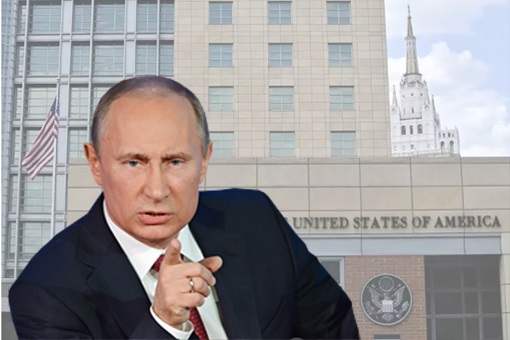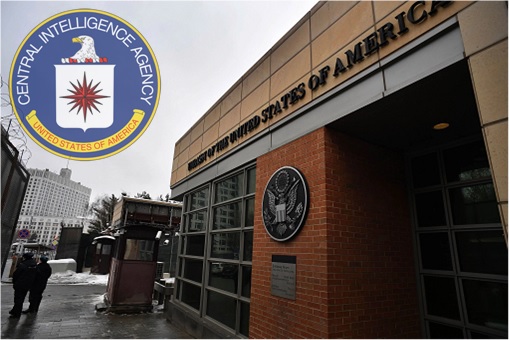The number is 755 – that’s how many U.S. diplomats have to leave Russia by September 1. In essence, that means there’re 1,210 U.S. diplomatic employees currently employed at the U.S. Embassy in Moscow and consulates in St. Petersburg, Yekaterinburg and Vladivostok. However, the United States has not confirmed how many diplomatic employees are in Russia.
Russian President Vladimir Putin sought to reduce the number of US diplomats operating in Russia to 455, a figure equal to the number of Russian diplomats in the United States. The numbers of Russian diplomats were reduced back in December 2016 after former President Barack Obama signed an executive order expelling 35 Russian diplomats.
Effective August 1, Moscow will also seize two buildings belonging to the U.S. – a diplomatic warehouse on the Dorozhnaya Street and a dacha compound along the Moscow River where staff members walk their dogs and hold barbecues. This was in retaliation to Washington’s seizure of two Russian diplomatic compounds in Maryland and New York, also happened under Obama administration.

One day after the U.S. Senate approved a measure expanding economic sanctions against Kremlin; the Russian Foreign Ministry responded by booting out the U.S. diplomats. On Sunday, a senior US State Department official responded to Russia’s demand, saying – “This is a regrettable and uncalled for act. We are assessing the impact of such a limitation and how we will respond to it.”
However, it wasn’t the Russian’s tit-for-tat move that has gotten many Americans surprised. Rather, it was the mind-boggling huge number of diplomats under the U.S. government payroll. Michael McFaul, a former U.S. ambassador to Russia, said he was surprised by the target number – “When I was U.S. ambassador, we didn’t have that many Americans in Russia.”
Of course, not all of 1,210 employees presently working at the U.S. Embassy in Moscow were Americans. In 2013 alone, according to a State Department Inspector General’s report, the Moscow embassy and consulates in St. Petersburg, Yekaterinburg and Vladivostok employed 1,279 staff – included 867 “locally employed” staff and 333 U.S. “direct-hire” staff, from 35 U.S. government agencies.
We dont have 755 American diplomats in Russia. http://t.co/KpgZMdCODP
— Michael McFaul (@McFaul) July 30, 2017

Essentially, that breakdown from 2013 data suggested the actual number of Americans forced to leave Russia would be far less than 755. Still, the fact remains that the U.S. embassy and consulates employ a bloated 1,210 staffs. While McFaul said Russians should expect to wait weeks if not months to get visas to enter the U.S. with the Kremlin’s retaliation, there’s one thing he didn’t disclose.
Most of the staff employed, similar to Russia Embassy in the U.S., were working for the Intelligence Community – NSA, CIA and whatnot. Obviously, the U.S. employs more intelligence officers or spies in Russia than the Kremlin’s spy agencies Foreign Intelligence Service (FIS) and GRU (Glavnoye Razvedyvatel’noye Upravleniye or simply Main Intelligence Agency) do.
Assuming the U.S. Embassy will cut mostly Russians being employed; its intelligence unit will be severely crippled. In comparison to only 35 Russians expelled by President Obama shortly before he left office, a cut of 755 employees, diplomats and technical workers on the part of President Putin is too dramatic and excessive – even if measured by the standard of the Cold War.

Even during the days of the Cold War (1949 – 1991), retaliatory expulsions numbered in the dozens rather than hundreds, such as when the Reagan administration ordered out 55 then-Soviet diplomatic personnel in 1986. Putin’s retaliation is the single largest diplomatic staff expulsion, comparable only to the closing of the American diplomatic presence in 1917 during the Communist revolution.
Amusingly, the State Department had invited criticism when it described the U.S. sanctions (on Russia) as a bid to improve ties with Moscow. But kicking out two-thirds of diplomatic and technical staff could be just the beginning. President Vladimir Putin said that Moscow could consider additional measures against Washington as a response to new U.S. sanctions approved by Congress.
For example, Russia could start banning U.S. consumer goods, which could affect sales of anything from Coca-Cola to iPhones to Ford cars. However, Putin said he’s against such extreme move – for now. And he would certainly like to see how the U.S. plans to stop a new pipeline project – Nord Stream 2 – that would carry natural gas from Russia to Germany.

Other Articles That May Interest You …
- Putin Retaliates – Kicks Out U.S. Diplomats, Seizes Properties … EU Supports Russia
- There’s Only 1 Reason Trump Walks Away From Climate Deal – To Piss Off The Left
- Badass Trump Lectured & Insulted EU Leaders – No Money, No Defence
- U.S. Intelligence Community: Now We Go Nuclear – “He Will Die In Jail”
- Trump’s Worst Enemies Aren’t Russia Or China – It’s Within America
- Obama Sanctions Russia, Putin Retaliates With A Duck & A Word “Lame”
- New York Times Admits Anti-Trump Bias, Now Promises To “Report Honestly”
- BREXIT 2.0!! – Here’re 12 Major Reasons Trump Wins Presidency, Against All Odds

|
|
July 31st, 2017 by financetwitter
|


|

|

|

|

|

|




























Comments
Add your comment now.
Leave a Reply